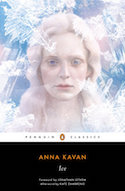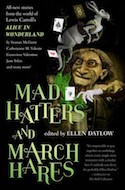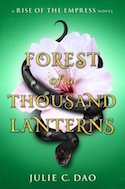Future Alternative Past: where's the future wear?
Every month, Nisi Shawl presents us with news and updates from her perch overlooking the world of science-fiction, fantasy, and horror. You can also look through the archives of the column.
Fashion: Beep beep.
When I was little, my parents subscribed to Life magazine. It was our weekly dose of glossy photojournalism: enormous pages full of news and human interest stories. Though it’s been more than fifty years since I saw it, the Life article predicting 21st-century fashions still troubles my mind’s eye. I’ve lost the names of the designers consulted — famous ones, no doubt, given the publication’s prestige — and am left with a problematic whirl of brightly patterned muumuus, bald heads, and an inexplicable dearth of earbuds. Apparently Life was following a long tradition of magazines getting such predictions horribly wrong.
Has SFFH fared any better?
My favorite antidote to the unease Life stirred up in me is Samuel R. Delany’s brilliant, multiple award-winning novelette “Time Considered as a Helix of Semi-Precious Stones.” What works best for me is an early throwaway line about “a crowd of giggling, goo-chewing schoolgirls with flashing lights in their hair, all very embarrassed at wearing transparent plastic blouses which had just been made legal again” — that “again” signifying the undeniably cyclical nature of fashionableness.
And really, despite the sober idiocy of the formfitting unitard look promoted by matinee serial fodder like Buck Rogers, and the camp idiocy of the shoe phone used in the semi-futuristic TV series Get Smart, that’s what the genre has consistently gotten right: the inevitability of repetition and change. Another example: characters in Bruce Sterling’s 1998 novel Distraction wear hats as routinely as actors in a Frank Capra film. Headgear’s a given, barely remarkable — our current hatlessness is noted as a brief historical aberration. Actually, who’s to say it isn’t?
Speaking of shoe phones, while they were one of Get Smart creator Mel Brooks’ finest standing (ba-dum-BUM!) jokes, they do reflect an emerging reality: wearable communication and computation devices. Google Glasses have not taken the nerd community by expected storm, but their sfnal prototypes are popular, from William Gibson’s cyberpunk through Accelerando and related works by Charles Stross.
Another sartorial SFFH trope — disposable clothing — seems even further from realization. So far, 3D printers are no help. The kicky-mod-paper-dresses of the 1960s have given way to hazmat suits and adult diapers. And ubiquitous though recycling hoppers are on many fictional space stations and starships (I oughta know, having installed them in a few of my own stories), the process by which their contents get reconstituted into wearables is never explored. Therefore, we’ll score this concept as pre-execution.
A final kind of fashion in which SFFH takes the lead: body modification. Representations in imaginative literature range from integrated technology such as the “Zeiss-Ikon” eye-cameras in Gibson’s “Burning Chrome,” through the race-encompassing genetic modifications enabling my “Maggies” to work unprotected on an alien world, to the DIY anti-hallucinogen-manufacturing brain implants employed by the biohackers in Annalee Newitz’s novel Autonomous. Call me bereft of acumen, but I’m betting we’ll always want to improve ourselves, always be willing to revise our bodies and genomes. And that the sorts of revisions we make will vary with our abilities, but also, naturally, with what we perceive as new and cool.
Recent books recently read

Anna Kavan’s Ice (Penguin), out now in a spiffy “50th Anniversary Edition,” is ultra-cool, and experimental enough that it will always in some way be new. This surreal proto-feminist account of a nameless male bureaucrat questing after a nameless female fugitive in the down-crashing shadow of a global eco-catastrophe is an astonishingly easy read, given its uncompromising weirdness. Lyric simplicity underlines the glacial starkness of the coming of a worldwide winter:
Banks of solid ice edged the narrow channel of blackish water, fringed with grinning icicle-teeth. I jumped ashore, snow blew out in great fans, the launch disappeared from sight. There were no goodbyes.
Conflating the crystalline fragility of the fleeing woman with the overwhelming power of the encroaching glaciers, opening up narrative discontinuities like bottomless rifts in a polar icepack, Kavan earns every iota of the respect paid her work by Anais Nin, Christopher Priest, Brian Aldiss, and Jonathan Lethem, author of this volume’s awestruck introduction.

Renowned multiple award-winning anthologist Ellen Datlow has edited dozens of books stuffed full of good stories. Her specialties are dark fantasy and horror, and her latest, Mad Hatters and March Hares (Tor), provides a new way of combining these genres in her authors’ original tributes to Lewis Carroll’s Alice books. Unusually, Mad Hatters’ Table of Contents includes more females than males. Perhaps that’s due to the femaleness of the original series’ main character? If so, the point remains unbelabored. The spotty magic of Priya Sharma’s “Mercury” poignantly underlines capitalism’s careless reliance on toxins and its heartless expediency in the light of loss or damage to the lives of its creators. Catherynne M. Valente recounts a braided tale, “The Flame After the Candle,” in which an adventurous schoolgirl climbs through an old, neglected mirror to find relics left by a New York encounter between Alice Lidell — the real-life model of Carroll’s heroine — and Peter Llewelyn Davies, the boy on whom J.M. Barrie based Peter Pan. These and Andy Duncan’s brilliant “Worrity, Worrity,” which soaks the dry biographical material of Carroll’s illustrator, Sir John Tenniel, in an elixir of fabulous coincidence, are the strongest stories in an anthology featuring strength after strength.

Two authorial decisions make newcomer Julie C. Dao’s Forest of a Thousand Lanterns (Philomel) a standout. First, no wypipo: in this fantastic China analogue, the closest readers come to a Caucasian viewpoint is the occasional mention of “barbarian” violins. Not that the realm of Feng Lu is suspiciously isolated; an ambassadorial entourage from the Nipponesque land of Kamatsu plays a major role in helping heroine Xifeng attract her emperor’s romantic regard. Second, said heroine is actually our villain — at least, I’m betting that’s how the rest of this series will shake out. Dao’s depiction of Xifeng’s struggle against the evil within is vivid and believable, her horror at her own burgeoning monstrosity always seems as if it might keep her from perpetrating her evermore dastardly deeds. Riveting inner turmoil sets the stage for an epic conflict to come.
Couple of upcoming cons
Seattle’s Rustycon has been happening for over 30 years. In addition to the usual writer and author Guests of Honor, they’ve invited a Gamer and a Furry as GOHs. Membership runs between 500 and 700 people, so this will be a small crowd of fandom's usual suspects. That’s January 12 through 14; mark your calendars.
On the following weekend, in fabled, far-off Detroit, I’ll be the Fan Guest of Honor at ConFusion Through the Looking Glass, latest iteration of the first con I ever attended. Back then, I dressed up as GOH C.J. Cherryh, my idol; now, I’m joined in playing myself in that role by several big names, including two who are also my friends: Annalee Newitz and Kate Elliott. Though I’m a little worried about the acclimatization of Kate, who currently paddles a blissful Hawai’ian kayak. At least she’ll have her fantasies to keep her warm. You too?